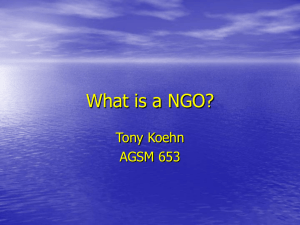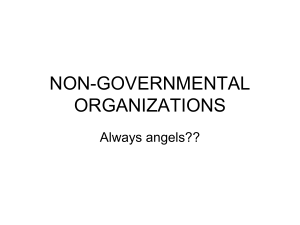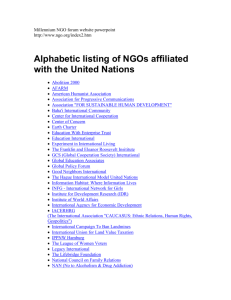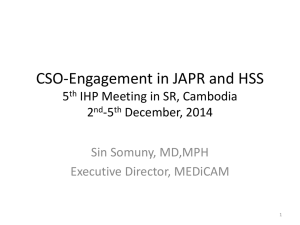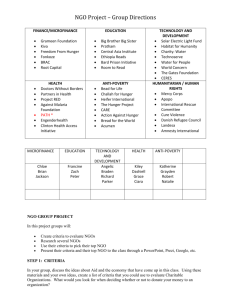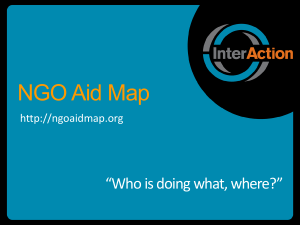KA7
advertisement
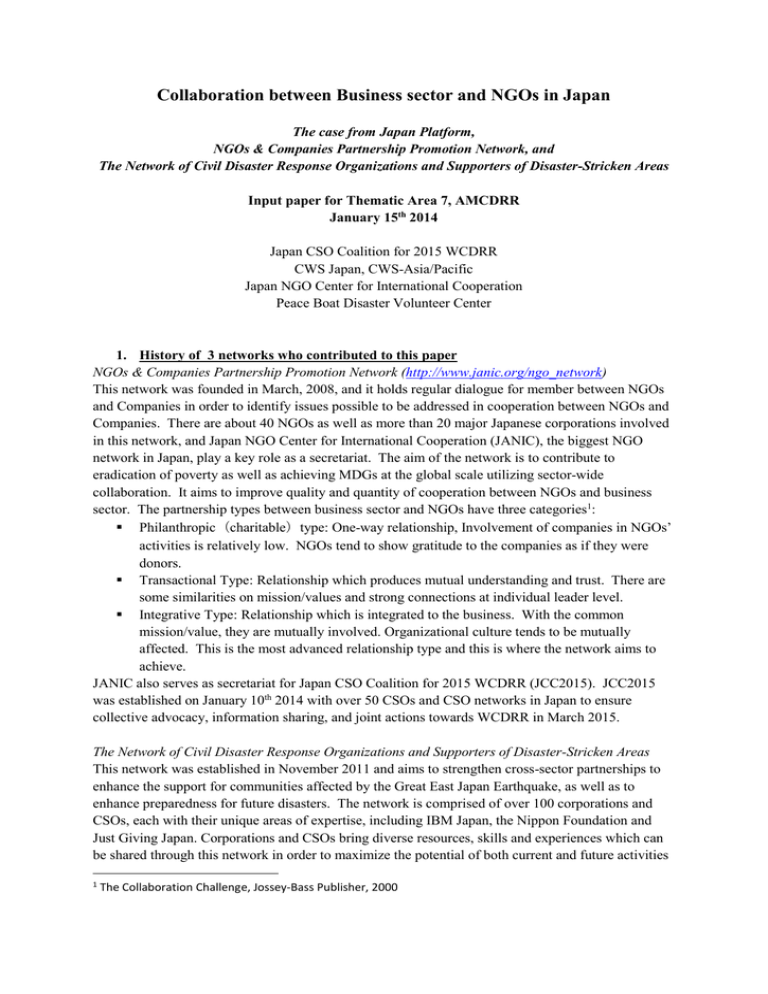
Collaboration between Business sector and NGOs in Japan The case from Japan Platform, NGOs & Companies Partnership Promotion Network, and The Network of Civil Disaster Response Organizations and Supporters of Disaster-Stricken Areas Input paper for Thematic Area 7, AMCDRR January 15th 2014 Japan CSO Coalition for 2015 WCDRR CWS Japan, CWS-Asia/Pacific Japan NGO Center for International Cooperation Peace Boat Disaster Volunteer Center 1. History of 3 networks who contributed to this paper NGOs & Companies Partnership Promotion Network (http://www.janic.org/ngo_network) This network was founded in March, 2008, and it holds regular dialogue for member between NGOs and Companies in order to identify issues possible to be addressed in cooperation between NGOs and Companies. There are about 40 NGOs as well as more than 20 major Japanese corporations involved in this network, and Japan NGO Center for International Cooperation (JANIC), the biggest NGO network in Japan, play a key role as a secretariat. The aim of the network is to contribute to eradication of poverty as well as achieving MDGs at the global scale utilizing sector-wide collaboration. It aims to improve quality and quantity of cooperation between NGOs and business sector. The partnership types between business sector and NGOs have three categories1: Philanthropic(charitable)type: One-way relationship, Involvement of companies in NGOs’ activities is relatively low. NGOs tend to show gratitude to the companies as if they were donors. Transactional Type: Relationship which produces mutual understanding and trust. There are some similarities on mission/values and strong connections at individual leader level. Integrative Type: Relationship which is integrated to the business. With the common mission/value, they are mutually involved. Organizational culture tends to be mutually affected. This is the most advanced relationship type and this is where the network aims to achieve. JANIC also serves as secretariat for Japan CSO Coalition for 2015 WCDRR (JCC2015). JCC2015 was established on January 10th 2014 with over 50 CSOs and CSO networks in Japan to ensure collective advocacy, information sharing, and joint actions towards WCDRR in March 2015. The Network of Civil Disaster Response Organizations and Supporters of Disaster-Stricken Areas This network was established in November 2011 and aims to strengthen cross-sector partnerships to enhance the support for communities affected by the Great East Japan Earthquake, as well as to enhance preparedness for future disasters. The network is comprised of over 100 corporations and CSOs, each with their unique areas of expertise, including IBM Japan, the Nippon Foundation and Just Giving Japan. Corporations and CSOs bring diverse resources, skills and experiences which can be shared through this network in order to maximize the potential of both current and future activities 1 The Collaboration Challenge, Jossey-Bass Publisher, 2000 within all phases of the disaster cycle. Peace Boat Disaster Volunteer Center (PBV) serves as a secretariat. The main objectives of the network are as follows: Encourage cross-sector cooperation and continue effective support for areas affected by the Great East Japan Earthquake Share resources, experiences and lessons learnt from network participants to improve preparedness for future disasters. Japan Platform (http://www.japanplatform.org/E/work/index.html)2 Founded in August 2000, Japan Platform (JPF) provides a platform to conduct international aid with a tripartite cooperation system where NGOs, business community (Keidanren – the biggest business association in Japan), and government of Japan (Ministry of Foreign Affairs) work in close cooperation, based on equal partnership, making the most of the respective sectors’ characteristics and resources. JPF’s origin was in Kosovo, when a massacre of ethnic Albanians aggravated, triggered by NATO’s aerial bombing started in April 1999, resulted to exodus of approximately 500 thousand refugees to neighbouring nations. Right after the incident, several Japanese NGOs started to examine the possibility of refugee assistance in Kosovo. The operation of refugee camp requires comprehensive and prompt aid activities ranging various sectors from food distribution, medical treatment, waste disposal, sanitation, and social welfare. The examination revealed, however, that Japanese NGOs were not able to implement effective aid activities independently; since the respective NGOs had neither sufficient financial foundation nor staff-members with considerable on-the-job experience to implement aid independently. Consequently, four NGOs planed to implement assistance activities by jointly establishing a camp in Albania, named “Camp Japan” for Kosovo refugees. The plan itself was not realized due to the return of refugees to Kosovo followed by ceasing of aerial bombing. Taking into account the lessons learned from the Camp Japan plan, a new framework, a “Japan Platform” conception was formulated. The objects of the framework is that NGOs, business community, and a government agency (Ministry of Foreign Affairs) work together for the prompter and more effective implementation of emergency aid with a tripartite cooperation system, based on equal partnership, making the most of the respective sectors’ peculiarities and resources. In preparation for a flood of refugees or a devastating disaster, Japan Platform has improved standby functions, such as making emergency aid plans and storing emergency aid supplies, taking advantages of know-how and resources of the respective actors. CWS Japan is a member of JPF as well. 2. Relevance to key questions What is the issue that your country (organization/stakeholder group) recommend to prioritize in HFA2? In order to enhance collaboration between business sector and NGOs, more emphasis on coordination and engagement should play at regional/local level and not only in capital cities (e.g. Tokyo). To achieve this, contribution from both NGOs and business sector (and preferably with back-up from government) to keep such nation-wide network going on from both financial sense and human resource sense. Through above coordination, integrative type of partnership between business sector and NGOs become possible. These networks also need to ensure that core competencies of the members (both corporations and NGOs) are identified and shared on constant basis in prior for any joint action. 2 JPF is a collaborator in this paper, which means that although they offered case story and inputs towards this paper, JPF is not officially among agencies who are putting these requests. Coordination mechanism between business sector and NGOs ensure that the collaboration is based on: o Shared aims/mission/purpose with understanding of difference and uniqueness of both sectors o Notion of ‘responsible business’ and value not only economic perspectives but social and environmental perspectives o Understanding local needs with longer-term solution-oriented perspective Have appropriate focus on Small and Medium Enterprises (SMEs) as their role in community level activities and environment can be much bigger than mega-coordination at capital city level. Emphasize on the networking that creates personal relationship between CSR representatives from corporations and NGO representatives. This would allow in-depth understanding of resources each stakeholder has, and such understanding plays a key role when it comes to exploring collaboration opportunities. Why have you selected this as a priority? What is the progress and challenges in addressing this issue? Progress is definitely establishment of networks such as JPF and NGOs & Companies Partnership Promotion Network. Challenge is how to ensure that the Integrative Type of relationship is formulated within such networks. Without proactive establishment of enabling environment, relationship usually end with philanthropic type and/or transaction type. It is important to note that CSR representatives often seek for information and materials they can utilize to convince the management on the company’s CSR strategy. For this, ability to propose win-win solutions from NGOs are required. This point is evident from frequent request from companies such as ‘please be explicit what are needed on the ground and what you need from us’. Did HFA1 play a role? If not, why? HFA1 played a very limited role, because in Japan, HFA in general is considered a framework for only developing countries. Awareness on such international framework needs to be enhanced at various levels in Japan. What are the actions required to address this issue? (maximum 5 actions) Promote business/NGO collaborative network in different parts of the country, and to provide necessary support to enable this. Disseminate best practices of Integrative Type of relationship between business sector and NGO sector. Such dissemination should take place at local/national levels, as well as regional and global levels. Focus on the role of SMEs as they are usually the ones who are closest to the local communities. 99.7% of corporations in Japan are considered SMEs as per Ministry of Economy, Trade and Industry’s statistics from 2012. There are region-based networks available (such as Corporate Volunteers Social Welfare Council encourage to establish), and such networks are great places to start region/local based networking to seek collaborations. From Japanese networks’ experience, incentives of companies to engage in CSR activities is not only business interest, but rather prior relationship and friendship affect greatly to where companies want to get involved. To utilize such characteristics, it is important to identify which companies would be sympathetic to which geographical area or segment of population, and to propose collaboration possibilities with those companies (so not one-size fits all). Have clear guideline and emphasis from Government (e.g. Cabinet Office) or business association (e.g. Keidanren) on how companies can play a role in communities’ DRR efforts. Such central and top-down messages are often heard by the companies as it is in their interest to be attentive to what the leaders say. On Global Compact, there are increasing participation from Japanese companies. NGOs can be attentive to such characteristics of the companies, and to seek shared vision and purpose based on this foundation. List the stakeholders who should be engaged in implementing the recommendations made above. What could be the mechanisms to engage and build partnership between the stakeholders? Existing coordination networks – proactively identify and share core competency of each members and aim for integrative type of partnership. UNISDR – share the best practices globally on integrative type of partnership. NGOs / NGO networks – involve business sector in their coordination activities and enhance understanding of core competencies of the business sector and their involvement in social benefits. Governments – provide appropriate tax incentives for social work by the companies, and to provide some grant schemes to ensure appropriate coordination between business sector and NGOs take place. But more importantly, governments are encouraged to send key messages to domestic industries how it want to see advanced level of collaboration between companies and civil society in order to achieve common interest (e.g. decreased risk from hazards). Business associations – involve NGOs in coordination activities and enhance understanding of core competencies of the NGO sector and their involvement in social benefits. Based on the foundation of establishing national DRR platforms, more emphasis should be given on inclusion of private sector into such coordination network. If NGO-private sector coordination network is already available in country, one should consider utilizing it. If it doesn’t exist, creation of such networks can be considered, and best practice from around the globe should be shared while establishing / strengthening such networks. How should this issue be addressed in HFA2? What could be the accountability framework to address this issue in HFA2? Who needs to be accountable to take the recommended actions? Who are the actors will be accountable to? What targets and indicators could be used to measure progress and underpin accountability measures? How can these targets and indicators be monitored and measured? Accountability framework: o Clarify responsibility of each stakeholder to enable this coordination to aim for integrative type of relationship for social benefits. Who needs to be accountable: All stakeholders need to be accountable, but primarily NGO networks and business association. The government needs to ensure that appropriate enabling environment is provided, and progress is reported under its HFA2 periodic monitoring report. Accountable to: This should be clarified and shared on case by case basis. For example, when working for DRR in other developing nations, community members of these countries ultimately need to be primary beneficiaries. Targets and indicators: o Existence of network that brings together business sector and NGOs (this is a prerequisite for any collaboration between business sector and NGOs). Connections between different networks are also important factor. o Number and details of collaborative cases in each type (philanthropic, transactional, integrative). o Clear messages provided by either the government or business association to encourage such collaboration between companies and civil society for common purpose. Monitoring and measurement: o Progress needs to be reported by these networks to contribute to national HFA2 monitoring report. 3. Case stories Substantiate the recommendations with an example of good practices (2-3 pages maximum) using the suggested template attached Case Story 1: from JPF Title of the Good practice/case study Creating synergy by linking contribution from companies to NGO’s relief and recovery for effective collaboration Abstract JPF has created list of contributable items from companies to assist NGO/NPO’s3 activities in East Japan Earthquake and Tsunami (EJET) affected area. By doing so, JPF was able to link the contribution from companies for relief and recovery activities effectively. Context The network to link companies and NGO/NPO was still weak, and it led to difficult in access of relief items from companies and delay in such logistics. Furthermore, if contribution comes from core business of each companies in solo, it is difficult to be need-based as it is supply-driven. In other words, someone needs to coordinate such assistance based on the needs of the affected areas. How the problem was addressed? 3 After EJET, many companies tried to provide material aid to the affected sites, but it was difficult for them to coordinate with NGO/NPO working in the area. JPF has designated one officer to handle this coordination, and made a list of contributable items from companies which was then shared with NGO/NPO working in the affected area. This has enabled one stop provision of information on what can be provided, and it worked as point of contact for both companies and NGO/NPO. Each company sought to provide their core business product in order to assist the affected areas, but it was difficult to lead to an effective relief and recovery with such supply-driven contribution from one company alone. Nissan Motor Co. Ltd. has decided to provide vehicles for EJET relief. These vehicles had some issues (such as with the number plates) and they were only allowed to be used in Japan for a short while. Therefore, Nissan Motor Co. Ltd. wanted these vehicles to be used for EJET relief initially, but later on to be sent to Africa for humanitarian activities there. JPF has discussed this matter with member NGOs, and designated some NGOs to receive these vehicles. As March is still in winter and Northeast region in Japan snows a lot, studless winter tires were necessary. On this issue, JPF met with In Japan, organizations who work for overseas cooperation are usually referred to as NGOs, and organizations who work on domestic issues are referred as NPOs. Bridgestone Corporation to have these tires provided for free of cost. Furthermore, after relief phase of EJET, Nippon Yusen Kabushiki Kaisha (NYK LINE) offered to ship these vehicles for free to Africa. The vehicles are currently utilized by Japanese NGO’s humanitarian activities in Africa. JPF has ensured each contribution by companies are utilized effectively by providing such coordination role. Results By linking each contribution from companies, JPF was able to create a synergy (big value) which allowed the contributions to be utilized effectively. Element for such success is constant relationship building JPF has undertaken before EJET. This allowed JPF to understand what each companies are able to provide, which led to brainstorming on possible combination of each contribution. Measuring success The success has been measured by how much impact such combination of each contribution by companies produced. Relevance to HFA 1 This case contributes to HFA1’s Priority for Action 5 as it enhances companies’ contribution to humanitarian actions. However, it is not sure whether HFA1 contributed to this case. It is necessary to disclose such effective collaboration cases proactively. (optional) Potential for replication Contact Collaborator: Mr. Naoya Hirano It is possible to replicate by ensuring a list (menu) of contributable items from companies is made and shared, and link them to relief and recovery activities proactively. Liaison Officer, Japan Platform naoya.hirano@japanplatform.org Case story 2: NGOs & Companies Partnership Promotion Network Title of the Good practice/case study Provision of IT Cloud service for Relief Phase of EJET Abstract Data related to needs assessment during initial relief phase of mega-disaster can be overwhelming in terms of amount of information that needs to be gathered, assessed, analyzed, and shared. Cloud service from Fujitsu Limited enabled provision of IT platform that allowed utilization of vast amount of information on needs of the affected communities. Context After EJET in 2011, vast amount of information gathered on needs of affected communities were hard to be assessed, analyzed, and shared systematically. Many local government offices were also affected by tsunami and nuclear accident, and information handling was not done effectively. There were need for How the problem was addressed? Fujitsu Limited has dispatched IT engineer to affected areas who established cloud system within 5 days. This system is also used for managing prevalence information of bird flu and foot-andmouth disease. This SaaS type Cloud system enabled management of vast needs related information within one platform, which can produce statistical outputs with search engine function. Results The intervention expedited information management during relief phase. Key elements of success has been Fujitsu Limited’s commitment to protect social infrastructure that they established in the affected area. There were over 1,500 staff from the company that were dispatched to the affected sites. Measuring success The outputs from this Cloud system was widely shared and utilized by aid community during EJET relief phase. Relevance to HFA 1 (optional) This case contributes to HFA1’s Priority for Action 5 as it enhances companies’ contribution to humanitarian actions. However, it is not sure whether HFA1 contributed to this case. It is necessary to disclose such effective collaboration cases proactively. Potential for replication Contact Mr. Takeshi Tomino By learning more in depth how Fujitsu Limited contributed using their core IT strength for EJET relief, it is possible to replicate such practice globally. Deputy Secretary General, JANIC Secretariat of Japan CSO Coalition for 2015 WCDRR ttomino@janic.org Case story 3: Network of Civil Disaster Response Organizations and Supporters of Disaster-stricken Areas Title of the Good practice/case study Abstract Context How the problem was addressed? Results Measuring success Cross-sector cooperation between CSOs and Corporations encourage involvement and maximize effectiveness of activities in Disaster Risk Reduction In the wake of EJET, a significant number of corporations worked in partnership with CSOs to provide relief to affected communities. The Network of Civil Disaster Response Organizations and Supporters of Disaster-stricken Areas was established in 2011in order to maximize the potential for these kinds of cross-sector partnerships to assist areas affected by EJET, as well as to improve preparedness for future disasters. The EJET was a major disaster that overwhelmed governmental, corporate and civil organizations. In hindsight, had strong partnerships between the private and civil sectors existed prior to the disaster and if cross-sector agreements had been in place, relief activities could have been more effective and efficient. Looking towards the long-term recovery of the Tohoku region as well as the occurrence of future disasters, it is vital that experiences, lessons learnt and resources are shared between both the civil and private sectors and these partnerships are strengthened to improve future responses. The Network of Civil Disaster Response Organizations and Supporters of Disaster-stricken Areas encourages these kinds of partnerships in the Tohoku region. Starting in May 2013, a number of network participants visited Onagawa Town in Miyagi Prefecture in order to build relations with the local communities and determine ways in which they can support long-term recovery. Having found opportunities to support and manage projects focusing on health, education and tourism, the member corporations and CSOs are currently implementing these programs in close cooperation with local communities. Corporations and CSOs are able to share resources and expertise in order to contribute to the long-term recovery of areas affected by the EJET. These projects serve as a strong example of cross-sector Relevance to HFA 1 (optional) Potential for replication Contact partnerships that allow for more effective use of resources. This case story is relevant to HFA1’s Priority for Action 5 as it focuses on the private sector’s contribution to humanitarian crises and disasters. By replicating the formal process whereby corporations and CSOs can share experiences and lessons learnt regarding past disasters, future disaster-related activities can be improved. Mr. Takashi Yamamoto President, Peace Boat Disaster Relief Volunteer Center junior@peaceboat.gr.jp 4. Contact Lead author, CWS-Asia/Pacific / CWS Japan: Takeshi Komino, Head of Emergencies takeshi@cwspa.org.pk Contributor: JANIC (secretariat of Japan CSO Coalition for 2015 WCDRR), Takeshi Tomino, Deputy Secretary General ttomino@janic.org Contributor: Peace Boat Disaster Relief Volunteer Center, Takashi Yamamoto, President junior@peaceboat.gr.jp Collaborator: JPF, Naoya Hirano, Liaison Officer naoya.hirano@japanplatform.org




